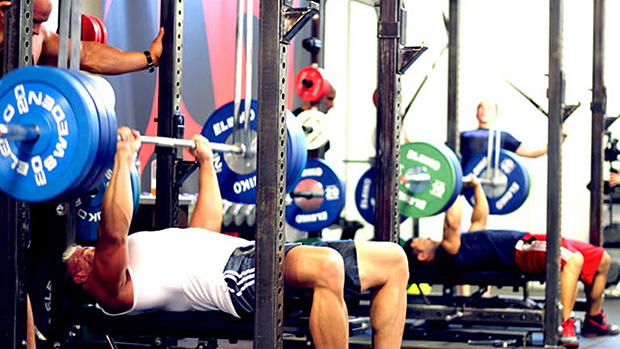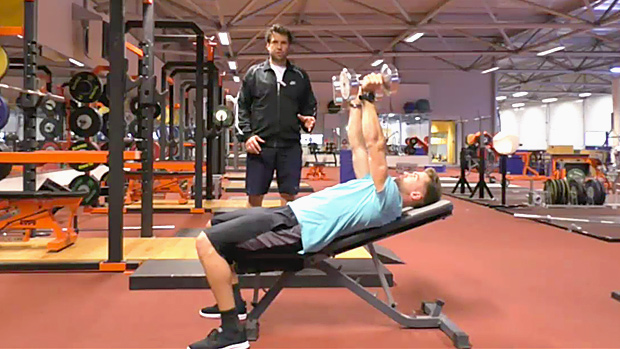Here's what you need to know...
- To get in position, grab the bar with an underhand grip, lift your body off the bench, and push your torso towards your feet creating an arch in your back. Your eyes should be under the bar.
- Grip the bar firmly before taking it off the rack. Take a deep breath and hold it. Pinch your shoulder blades together.
- As you press the barbell up, drive your heels into the ground and your upper back into the bench. Your elbows should be out, not tucked.
- Keep your butt on the bench.
- Powerlift the main lifts (1-5 reps). Bodybuild assistance lifts (10-30 reps).
Of the major lifts, the bench press and the press are always the last to mature.
A lifter can enjoy five or more years of steady gains in the squat, power clean, and deadlift but still suffer numerous setbacks, plateaus, and frustration in the pressing game.
This is the natural order of the lifting world, especially for those that aren't physically gifted in the bench press.
I didn't press much for the first 10 years of training. Most of my training was dedicated to squatting, cleans, running, and jumping.
Upper-body work was definitely low on the priority list. Like many people who are dedicated to athletics, performance on game day takes precedence over trying to impress others in the weight room.
While I did bench press, I didn't give it much thought. In hindsight, I probably should've, but I'm glad I put my effort where I believed it was needed.
It did, however, take me seven years of training to go from 300 to a 400-pound bench press. That's a very long time – too long.
But after I pressed 400, it only took me three months to get to 455. I credit this to simply taking a step back and making my upper body stronger with simple, basic methods.
Those seven years taught me if you want to lift big, you have to be strong. And you have to be strong everywhere, which is something gimmicks fail to provide you.
Like life, success comes to those who persevere, not those who complain and give up. Here are some tips I've learned along the way that may help you.
Like anything in training, the key is to learn from the best and once you have adequate experience, tweak things to fit your own technique and style. Don't try something once and disregard it or start tinkering right away, especially if you don't have adequate experience.
Years ago I had the privilege of attending a seminar taught by Mike Miller of Nazareth Barbell and Bill Crawford of the Metal Militia.
These guys are both great pressers and had a very unique and disciplined way of setting up for the bench press. And if you learn from either of them, you'll develop a deeper understanding of just what being "tight" is all about.
It's beyond uncomfortable, but it works extremely well, even for raw pressers.
Here's a modified version of what I was taught and still use today. Do this on every set, especially the warm-ups. This will help reinforce the set-up, allow you to get used to the position, and get you ready for your heavier sets.
- Begin with your head off the bench press.
- Tuck your feet underneath you.
- Grab the bar with an underhand grip (it's much easier to pull yourself up and under the bar with an underhand grip), lift your body off the bench, and push yourself towards your feet. Do not let your feet move when you do this.
- Make sure you push yourself towards your feet until your eyes are under the bar.
- This is an uncomfortable position; get used to it!
- Your lower and upper back should be arched hard and you should feel very solid and strong.



Much has been said about the proper grip width for the bench press. Some favor a wider, 32-inch grip, which is considered maximum for competition.
While this shortens the distance of the press, it also puts a tremendous amount of stress on the shoulders and pecs. Also, if you're slower and weaker off the bottom, it could severely limit your bottom end strength.
A narrow grip (index fingers about 17" apart), lengthens the pressing motion but is much more shoulder and pec friendly. Any number in between (usually index fingers about 25" apart) is considered a medium grip.
Whatever grip you take, realize that there will be a significant difference in how you tuck your elbows, where the bar touches, and the bar path on the concentric portion.
Basically the wider your grip, the more your elbows should be tucked, the lower on your chest the bar will touch, and more pronounced the bar path will be (the bar will travel in a greater arc towards your face).
If you take a close grip, your elbows will be much more flared on the way down, the bar will touch higher on your chest and travel back in a straighter line (but still towards your face).
Younger lifters usually want to take a wider grip – they lift more weight this way and don't have the injuries that make this grip unusable by an older, more experienced lifter.
This is fine. I did this and many others have as well. Just realize that there's nothing wrong with taking a closer grip and having the patience to make it work in the long run.
- The most important factor when taking the bar off is to take it off strong. Squeeze the bar hard and take it off the rack like you own it.
- Before lifting the bar off the rack, take a huge breath and hold it.
- Make sure your shoulder blades are pinched together.
- As you press the barbell off the rack, drive your heels into the ground and your upper back into the bench.
- Take the bar off the rack with your elbows out, not tucked. The weight should and must be supported by your shoulders, chest, and upper back. Don't put the weight in your arms and elbows; put the weight on the strongest muscles.
I prefer to never use a lift off from a partner – this is a point of pride for me. I believe that if I can't move the barbell a couple inches off the pins, then I have no business lifting it.
It's like the people that want you to hand them dumbbells to do presses with. Go hire a trainer to count your reps as I'm not here to lift the weight for you.
There are two mistakes people make during the eccentric portion of the bench press: they descend way too slow or way too fast.
Going too slow makes good magazine and article fodder, but does little to help your bench press. All you're going to do is tire yourself out for the lift.
Going fast sounds great in theory, but you'll just lose tightness and the bar will get out of position.
The key is finding the happy medium, and one of the best ways to do this is with your grip – not the width of the grip but squeezing the hell out of the barbell.
When you squeeze the barbell (notice I didn't say "pull the bar apart," just squeeze the barbell like you would the neck of your oppressor), your body will remain tight and more importantly, you can lower the barbell with the correct speed.
You can't drop the barbell when your hands are squeezing it and controlling the barbell on the way down builds confidence.
I like to watch the barbell on the way down, which allows me to control the speed with my eyes. This might sound corny but it helps me lower the barbell with the correct speed.
Some people like to focus on a single point on the ceiling. I find this to be way too distracting and limiting. Every gym and meet is going to have a different focal point, but a power bar is a power bar.
Be sure during the descent that you keep your air in and "get thick." Don't let your arch fail or sag under the weight of the barbell and the movement of the descent. This is a sure sign that the backside of your body isn't strong enough to maintain the position. Solution: build your backside.
Once the bar touches your chest, it's time to explode. You must be ready to fire every part of your body into the barbell. This is where leg drive comes into play.
There's no secret to leg drive other than recognizing that the bench press, like the squat (you better be using your arms when you squat), is a total body lift. People have asked me repeatedly how to get leg drive in the bench press. The answer is simple: do it.
Once the bar touches your chest, think about "squatting the weight up." This doesn't mean pushing your feet into the ground and sliding across the bench – the force you push with your legs has to be directed into the barbell.
There's a big difference. One is an action; the other is an action with a concentrated purpose. Every muscle and every movement that you make must be directed into the barbell with the sole purpose of driving it up.
There should be no wasted energy; your head shouldn't be moving side to side or your butt wiggling. You're on the damn bench with a barbell in your hands so stay focused.

There are a million different training programs out there, and the best program to help your bench press is the program you believe in. Nothing can beat belief, not science or any drug. Belief in what you're doing can cure even the dumbest program.
I'll give some general advice that you can apply to any program, though:
When training the lift, either hit a rep record or do 3-5 heavy singles after the main work sets. The former lets you walk away from the workout feeling successful and confident.
For me, setting personal records, no matter how small, is why I love lifting weights. I could give two shits about "the pump" or what some shallow woman thinks of me when I take my shirt off. What I do care about is getting better. And setting a personal record is me getting better.
If I don't feel like I can get a PR or if I do set one, I always like to hit some singles after my 5/3/1 work sets. No, the PR won't get you too tired for singles (unless you're horribly out of shape and weak or have extremely low expectations for yourself).
I use my training max as a guideline. All singles will be at my training max or above. This ensures that I hit 90% of my max every time I bench press. The volume of the bench press is kept fairly low but the intensity high, always hitting singles but never missing.
The assistance lifts are done for much higher reps; I like to take a full range movement and perform 5 sets of 10-20 reps.
Some good choices are any kind of dumbbell presses, incline presses, dips, weighted push-ups, and log or football bar pressing.
After the pressing movements, move to prevention movements. These are the exercises that work the back of your body and keep your shoulders healthy. Again, these are done for higher reps (10-30) and for multiple sets (3-8).
These include any kind of exercise for your lats, upper back, rear delts, and biceps. I rarely even record these in my training log, but they're still important.
One of the best things I ever did for my bench press was to improve my grip. Grip work is like squats – every sport and athlete needs it. Besides Kroc rows, using a thick rope and rowing a weighted sled hand-over-hand has done wonders for my grip, arms, and upper back.
Also, with one surgically repaired shoulder and the other torn to hell, this always makes my shoulders feel great. It's highly recommended if you can get your hands on one.
My rope is 112 feet long, 2" thick, and I just load the sled up and pull it towards me. Simple as hell and effective. If you don't have access to a rope, start doing rope or towel chins.
I also highly recommend learning to press and make it a priority in your training. I credit the press as the main reason why my bench press jumped from 400 to 455 in such a short period of time.
When my press goes up, so does my bench press. For some, this may not be the case but I believe that one has to devote more than a few months or workouts before passing judgment. You need strong shoulders to bench press and nothing fits the bill like the press.
I have a bad shoulder. How can I work around or through this?
This is something most veteran lifters have gone through. Rest is the obvious answer (as is an MRI and a good doctor, and I'll assume these steps have already been taken). Here are a few more tips:
- Start squatting with a cambered bar.
- Eliminate any kind of pressing from your training other than the main lifts. Keep all assistance to pulling movements.
- Pause all your reps at the bottom.
- Make sure you warm-up thoroughly.
- If you've had shoulder issues in the past, don't stop the rehab. It should always be done as part of your training program. You don't stop fucking once you get married, and you shouldn't stop shoulder love once it's healed.
- Make band pull-aparts a steady part of your training. Do 100 reps every day.
I have sore elbows and can't press without pain. What can I do?
I had some awful elbow pain and one of the best things I did was take a few weeks off and let the inflammation die down. After I felt better, I eliminated all direct triceps work, especially extensions.
Using a wider grip while squatting also helped, as did stretching my shoulders before squatting. Using a cambered bar would also help greatly.
I've heard board presses work well for increasing the bench press. What are your thoughts?
Board pressing can definitely help but the one problem that always rears its head is that people become great board pressers and not necessarily better bench pressers. They simply learn how to use the board and heave the weight off it.
If you have the discipline to use boards correctly, i.e., not heaving or sinking into the board, they can be beneficial.
How do I keep my butt on the bench?
This is simple – just do it. People lift their butt for one reason: to lift more weight. Keeping your butt on the bench is nothing more than having the discipline to do so.
Doctors have successfully replaced a human heart with a pig's heart. I think it's more than reasonable to expect you to keep your ass on a flat surface while pressing a barbell.




